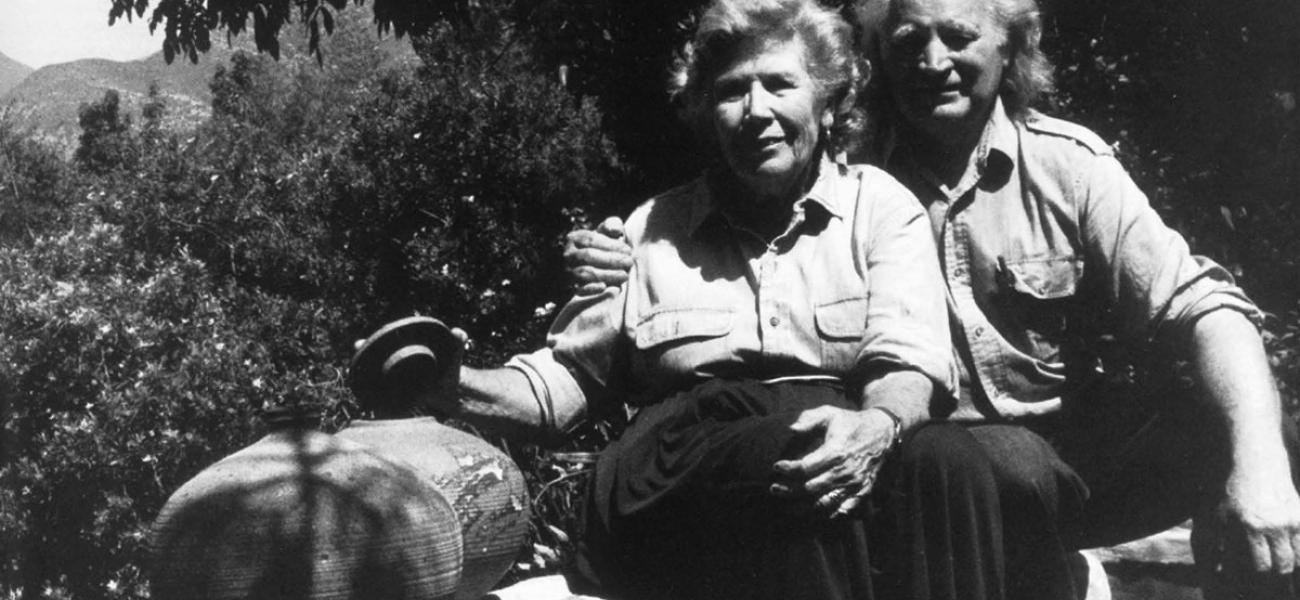Living Pots
Random Notes From an Interview: Ojai, California. An August morning, 1993. A long low house built on a hill. The sun is enthroned above the simmering valley. Birds hold congress in the trees. A huge podocarpus overspreads the roof, roots heave the cement walk. A work room opens toward a rock wall, a terraced herb garden is below. Lockerbee and Denver wheels sit on deck. Wood is piled high in the driveway, awaiting a kiln firing. A Border collie and small terrier sleep under a slab roller. Pots are everywhere. Two showrooms, one with a wall covered by diplomas and awards. A table is set on the patio for lunch: salad, vichyssoise, meat loaf, cobbler. Goldfish in a pond spit at low-flying insects. A peacock wails mournfully in the distance.
Vivika: I always was interested in pottery. One time when I was seven or eight my mother took me to a store in Rochester [New York] to see a Southern Highlands potter demonstrate throwing on the wheel. I remember how silently the wheel turned. The potter made a little pot, and when he cut it in half there was a little bird inside.
When I got home I decided to try it myself. Those were the days of Victrolas, and ours had a nice turntable covered with green felt. I took some sand from my sand box and tried to throw a pot as I had seen the potter do. But the sand wouldn't stay together. My father took me aside and told me you don't mix sand with furniture. Not for many years from that date did I make any pottery.
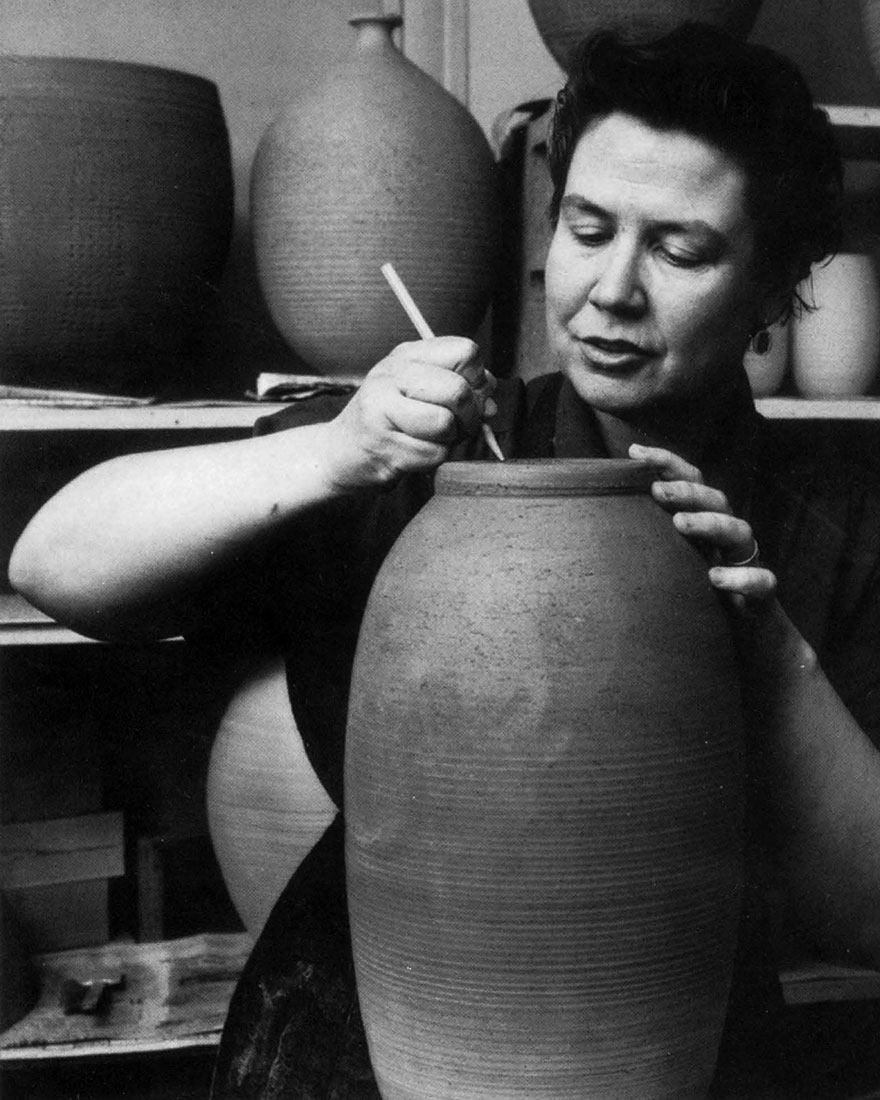
• • •
I was born and brought up in Caledonia, New York, about twenty miles from Rochester, and went to grammar and high school there. There was no art in school in Caledonia, so I used to go to Rochester to see shows. I remember one of the first I ever saw was a John Marin show at the Memorial Art Gallery. I was so excited here was the real thing! After high school, I decided I wanted to go on to art school. Our principal informed us that if you can't go anywhere else, go to Alfred University. We thought he meant it wasn't a good school. But later I found out, when I actually went to Alfred, that he was born there and had relatives living in town and liked it.
So, instead, I went to Rochester Normal School, a three-year school. I hated every minute of it. We had a lot of art, but it was for kids. I did take a design class offered by the University of Rochester, but it was frustrating-everything I did the teacher didn't like. I never knew whether this was to encourage or discourage me. We were quite near the Eastman School [of Music], and on my first day of art class the teacher spoke of composition, and I raised my hand and asked what composition had to do with art and drawing (thinking of music). Everybody laughed. The teacher said, "Just a minute, she comes from a school that has music composition" and went on to explain to me that the reference had to do with designing a picture.
When I finished there, I taught for a year. Then I had a chance to go to Colorado with some friends. In Greeley, I went to school at the Colorado College of Education. There was a fine art department, and, since Miss Baker back in Rochester foolishly had let me take all four years of art courses, including philosophy and principles of education, which I completed in one year, I was able to finish at Greeley and get my degree, AB in fine arts. I did my practice teaching there.
I decided to go for a Master's degree. It was my first exposure to a class where you worked with your hands. Although I was really a water color major, they offered wonderful bookbinding and jewelry classes. But as I began to read theses in these subjects, I began to think less of a Master's there.
Just then a puppet show came to town. In high school, my brother Roy and I had formed a puppet show, and so I was naturally intrigued and asked if I could go back stage. It so happened that I was told that one of the puppeteers had gone temperamental and left, and that they needed somebody to replace her. Right away, I got to play the afternoon and evening show, and the next day was invited to go on tour with them through Nebraska and Oklahoma. Since we were playing Cinderella with lots of acts-something I had done before-I could get right into it. We spent Thanksgiving touring Oklahoma, but the advance man flubbed off and didn't get any more dates, so I came back to school at Greeley.
Deciding not to pursue a Master's, however, I packed up my car just before Christmas and started to drive home East. For the trip I wore my riding pants and boots, just in case I had to change a tire. Everybody in Greeley talked about what an interesting place Taos was. Suddenly I saw a sign pointing in that direction. I decided to go East by way of Taos.
Arriving at Albuquerque, I felt grungy and went to the Harvey hotel to see if I could clean up. (When I look back on all this, I think, how did I dare do it?) I went up to the clerk and said to him, "How much is a room with a shower?" He said, "Help yourself to this room." So I cleaned up, and when I came out I saw a sign that said, "California and Los Angeles-This Way." I thought, "Gee, I'm so close to Los Angeles, maybe I'll never get there if I go back East." It so happened that some of the people from the puppet theater had called from Colorado and said they were going to California. I told them, "Maybe we could meet in Albuquerque." I waited for them, and when they arrived I drove along with them, straight through, night and day, to California.
It was Christmas eve when I arrived. The only person I knew was the daughter of a friend of my mother. I called her. She said, "Come over and stay." I must say, Hollywood never looked so beautiful as it did that day, all foggy and everything.
I needed a job. So when I got up the next morning, I called all the bookbinders I could find in the directory. (I had already bound some sixty books and felt I knew a little about it.) One bookbinder said he wouldn't hire women because women get married and have babies. Another, a delightful old German who bound Bibles and sheet music-two of the hardest things to bind-said I could work mornings; he'd pay me two-and-a-half dollars a week. This was during the depression, remember. I found a place to live for only ten dollars a month.
Since I didn't have the advantage of a family inheritance, I had to make a living. In those days, it was a necessity to know all the crafts, not just one. While I knew something about bookbinding, I thought I should go on from there and learn another craft. Clarence Muse bought me some tools [for metal work]. We went to nearby fish canneries and picked up scrap tin out of which to make things.
Not long after I had arrived in Los Angeles, a friend and I drove up to Carmel. Next door to where I stayed was Charlie Sayers, the woodcarver. He had just received a commission to do the interior on an entire Italian restaurant. He had two girls apprenticing with him, and I thought, "Gee, maybe I could apprentice with him, too."
I asked him, and he said, yes, that he would pay me a dollar a day. "You can't smoke cigarettes," he cautioned, "but you can smoke a pipe." (You see, a pipe would go out and not represent a fire hazard.) I worked with him for six months, but never learned to smoke a pipe. I stayed in a little painting studio with two women who were on state relief. The women picked mushrooms to eat and, because of state largesse, we had all the butter in the world.
I got a job as a reporter for a new little newspaper starting up in Carmel. I approached the publisher-an old gentleman working in the yard-and asked if I could have a job on his paper. He said, "Do you sell?" I said, "Yes." So I sold subscriptions. Each subscription cost two dollars, out of which I received one. I made forty dollars one week. I also wrote for the paper, such things as the beginning of commercially grown artichokes [in California], and about Italian weddings. I had a marvelous time. On one occasion, I asked an old man from Moss Landing for an interview. He said he didn't know if he could; he'd have to ask his mother. Which was a little startling, because the man was in his seventies. So I went inside and saw this incredibly spry little old woman of ninety-seven who had come West with Kit Carson and been kidnapped by Indians, and her father always told her to follow the river, which she did, and that's how she got back alone to camp. She took out all her clippings to show me. She'd been honored by being made the Oldest Woman in Modesta.
About that time I met a Japanese artist named Micky Hayakawa, and, with a friend, we all
went up to San Francisco. I had heard of a place called the Swedish Applied Arts, a weaving school that took students. So I decided to go out and meet Mrs. Gravanda at her school address on Pacific Avenue. I dressed for the occasion, and had on a cute little blue suit with a beret. I got lost, so approached a policeman to ask how I could get to Pacific Street. (At the time, Pacific Street was a famous red light district.) He looked me over and said, "What do you want there?" I said, "Work." He said, "What kind of work?" I replied, "With a woman who has a weaving school." He asked, "What's the address?" Then he said, "Oh, you want Pacific Avenue," and put me on the cable car going in that direction. Pacific Avenue was an elite district.
Mrs. Gravanda said, "Yes, you can come." At first the fee [for enrolling and living] was going to be thirty dollars a week, but when she found out I had a car she told me, "We certainly need to have things brought in," and reduced the fee.
We wove and wove. There were orders to make scarves to go on knitted dresses, and we wove thousands of them.
I don't know how much weaving I learned from Mrs. Gravanda, but every Thursday and Friday nights she served dinners to paying guests, and I was in charge of the herring and desserts. The basement was all fixed up like a little dance hall, and we demonstrated folk dancing, showing customers how to do the hamba and schottische. We did the whole Swedish bit.
• • •
I still didn't have any money. One of my friends taught at a nearby college, so I went there to see if I could get a teaching job. They told me I first would have to study at the college for two years. I explained I already had a license from New York State permitting me to teach anywhere, and an AB in fine arts. So then they allowed as how they needed someone to teach Americanization to Italians. I got the job at fifty dollars a week and taught basic English-how to read and ask for things. It was fun. I taught the mothers of Joe DiMaggio and Leo Castelli. The mothers wanted to take me home and feed me.
In the meantime, while I was teaching Americanization, I still worked at Swedish Applied Arts. But I soon found out that the school was moving two blocks away. I was having trouble with my thyroid and couldn't help with the moving, but all my friends moved the furniture there in a regular bucket brigade. I soon got a room in the [so-called] Monkey Block. This was a four-story building where famous writers, such as Bret Harte, had lived. It was a wonderful place, right downtown. I had a room with running water on the second floor, and the women's showers and toilets were on the fourth floor.
It was the Depression, and the WPA had begun. While living at Carmel, I had worked in Little Theater with Ted Custer and had been in quite a number of plays. Bill Gaskin, who was a painter and whose wife was an actress, was made head of the art project. I went over to see him. He said, "Well, you know what they need right now is a puppeteer. Why don't you get in on it?"
Ralph Chessy ran a marionette project. After it was over, he put me in charge of the NYA (National Youth Administration) for six or seven years. We carved marionettes and performed such plays as "The Two Philosophers," "Alice in Wonderland," and a review. So he put me in charge and I became Director of the NYA Marionette Project. We carved, sewed and staged marionette shows. We had a portable stage and performed at old people's homes, orphanages and schools.
We were soon invited to be located at the De Young Museum in Golden Gate Park. We put on a new show every two weeks, written by the educational director. The themes were Japanese, Chinese, Eskimo and Hawaiian. We worked for a week and a half, then rehearsed all Thursday and Friday and gave two shows on Saturday. I always seemed to be doing something that took too many strings, like balancing two puppets one above the other or building a totem pole in the Eskimo play: a bear, a seal, a bird with wings outstretched, a rabbit. If the project managers didn't know what to do with people, for instance, they were sent to me. "Oh, well, he or she can carve or do something." I had a lot of people like that.
By this time, I was getting $125 a week, which was pretty good pay for those times. But finally I got fed up and said, "Oh, I can't do another puppet show!" and resigned.
That's when I started making pottery. I had accumulated a month’s pay ($200) and immediately started selling pots. I think the bookbinding and jewelry helped my sense of form. I still have my first little piece; it was in a show "California Legacy" at Palos Verdes Gallery last year.
When I first set up my studio, there were only a few studio potters around, such as Janavok and Olsen and Carleton Ball. World War II had started, and stores were really wanting pots. I got an order from Carole Stupel in New York, and one from Carson, Pierie and Scott, Chicago, and from Marshall Field.
The World's Fair in San Francisco was in progress, and I was asked to demonstrate my puppets. (I also had pots in the Fair.) One afternoon, the Natzlers [Gertrude and Otto] came, and I spent my time trying to figure out which was which-they both had short hair and had on aprons, and they looked exactly alike. I remember Gertrude threw pots and Otto worked at glazing. He had a lot of cans, all colored yellow, containing such chemicals as red lead and potassium dichromate. I asked why they were all yellow. He said, "So no one will know what's inside them."
My first commission came from Blum's Candy: fifty covered jars for coffeettes, and five hundred plum pudding bowls. I didn't know what to charge for the jars so asked two and a half dollars each. I had to throw and fit each one. I made money on the bowls by press molding them and charging five dollars apiece for them.
I was so exhausted by the time I had completed the order for Blum's that I just wanted to sleep and not wake up. But at four o'clock in the afternoon, I woke to the radio blaring, "All men take cabs and go to your posts!" "Oh, no," I thought. "They've bombed the Philippines!" A girl who was using the studio that day said, "No, it's the Hawaiian Islands." It was Pearl Harbor, and it was a pretty harrowing time.
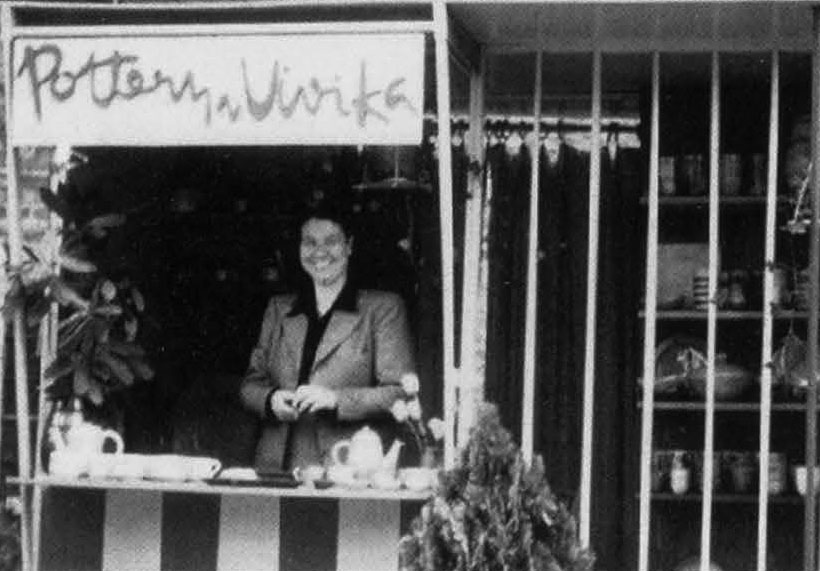
Well, I took his class anyway. I didn't get any pay but had to pay tuition. But he was marvelous! He didn't say, "You can't do that." He just said, "Try it." I used to make his soft white glaze by the gallon. He wouldn't let anyone glaze. Everyone had to stand in line and indicate what they wanted, then he would glaze everything. I couldn't see someone else glazing my pots, so I said to a boy who had taken the day class, "Bill, how do you glaze?" He told me how to use the spray gun.
Lukens was a very quiet man. He always wore a Hoover apron with a rope around it and white sneakers. He was always very encouraging. "You've got to get out and sell your work,” he said. This was during the war, when there were something like 500 people making pots in the Los Angeles area and having a heyday because there weren't any imports coming into the country.
When I came to study with Lukens, black slip was in vogue. I thought, "If you can make a black slip, why can't you make a black clay?" Lukens said, "Try it!" When he came back from Haiti, he told me, "You know, Vivika, you're the first one to do colored clays." Lukens glazed at cone 08. Later, when I returned to San Francisco, I wondered what would hap pen if I went to a higher temperature. I had a little test kiln and one day when cone 06 had gone down, the phone rang. Upon returning, I found that cone 04 had gone down, too. On opening the kiln, I found that all the crackle glazes had become clear. I told Lukens this, and said that I had read if you put silica into a glaze you can cut the crazing. I didn't realize he already knew it, but crackle glazes were his forte.
• • •
One day I got a letter from Alfred University offering me a teaching fellowship to work on a Master's. This had come about because some friends suggested I might get a grant called Rosenwald. To this end, I wrote to all the early people I knew who were doing ceramics-Cox, the people in Shearwater, in Georgia, in New Orleans and in Ohio. And I wrote Alfred. Evidently, Mr. Harder kept the letter, because he wrote asking if I would be interested in a teaching fellowship at Alfred. It seemed that Sam Haile [the English potter], who had been there one year, had moved on to Michigan, leaving an opening.
I called Mr. Harder on the telephone right away and told him I was interested. I mentioned I had had some pots at Syracuse. He laughed-I never knew
why he laughed. Anyway, I sent him my vita, which included a sort of letter of recommendation from Lukens, who said, "If you want somebody from out here who doesn't know anything but has a lot of energy, take her." Dr. Morley, director of the San Francisco Museum of Art, gave me a recommendation as well. She bought many of my first pots.
I was at Alfred for two years. There weren't any other graduate students at that time. Mr. Harder wasn't too well. He just demonstrated once, showing how to make a covered jar. By that time I had worked out how to calculate glazes. So Mr. Harder said, "You take Merritt's class." Merritt said, "You can't do that, you haven't any formal training." I said, "Well, Mr. Harder told me to take both classes and to show you my notebook." (I had made a transparent glaze, a magnesium matt and a calcium matt.) He said, "How did you know how to do all that?" I said, "From Binns' book." I took the class.
I was a workaholic. Sometimes I worked till four in the morning. The girls would have late leaves, and I helped them with their throwing. When they left, I could work on into the small hours of the morning before going home. The fellows all had gone off to war, and there were only a few students left to finish the year out. Dave Gill was there, but left. Conkie Kiegler was there, as were Lyn Linhoff and Norm Ruderman. There really weren't very many students.
I received $75 a month at Alfred and could just squeak by. My mother saved coffee coupons, and I was careful to run the coffee through twice. Hamburger was expensive at Alfred-85 cents; 40 cents elsewhere-but I lived off it. I think I paid $45 for my room. I got by.
In the summer I did my own work. It was a wonderful summer because everyone came back. I used to set seven kilns a clay. Then I got everybody so that they knew how to set kilns, and I worked with them on glazes. Harder had a section on glazes. You didn't sit around and chat a lot. Too much to do.
Mr. Harder was very quiet and very intelligent. He was knowledgeable and well read, but there wasn't much communication with others. I always loved to have a crit (by him]. I remember once taking him a bowl I had pulled out of the kiln. He looked at it silently and finally said, "Well, Vivika, there isn't anything you can add to that bowl or take away from it. It's good." Later, RabeJohn Gibbings, a designer, bought it in an auction for industrial designers; I don't know where it is now.
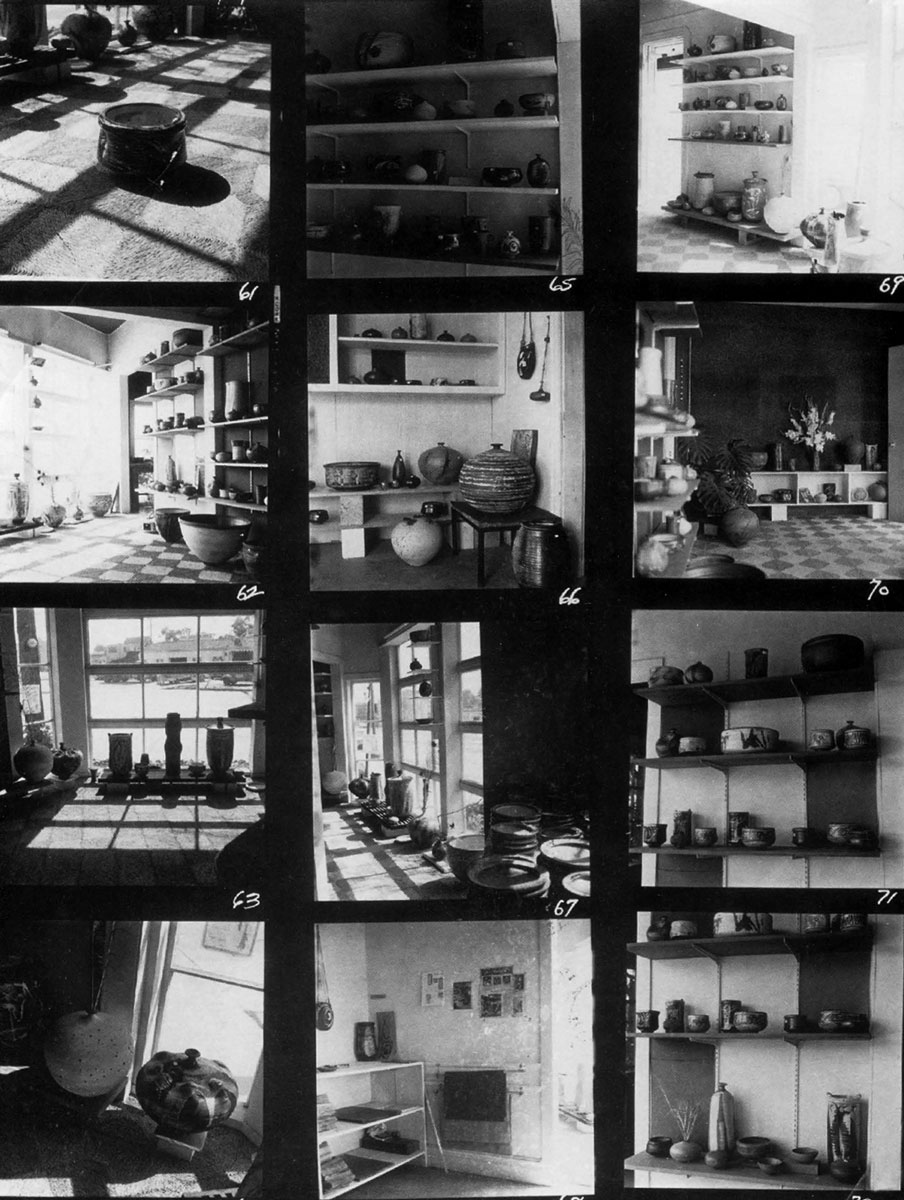
Doc Burnham had been at Alfred for four years working on his research in lusters. He finally got his degree the year I did. I still have the luster formulas he shared with me. In fact, that's what I gave to Beatrice [Wood] when she wanted to start doing lusters. Doc Burnham gave a paper on the subject at the American Ceramic Society and later went on to work at Coors[in Colorado].
At Alfred, Mr. Merritt lectured on glazes. But we never knew if they could be used. We just did calculation. He wasn't a potter, so he never carried it over, you see. I became very interested in the salt kiln. There wasn't any class in it, so I used to go up to Bob Campbell's kiln-building class. [Alfred teachers] were all so helpful. They would all stop and talk and were always very nice. Dr. Sutton was the plaster man, but Harder taught plaster and would give me one step at a time, and when I got that done, I'd go get him and do the next step. I remember that Dr. Scholes used to stop and talk with me. They all had me to dinner. It was a wonderful atmosphere.
I think the Alfred professors realized I was someone eager to learn. Because I was from the West Coast, they kidded me unmercifully about the bright colors of California. It was true. Nobody out here in California at that time did anything but blues and bright greens. At Alfred we started at cone 04, then went to cone 5, then fired the big saggar kiln with porcelain a couple of times to cone 10. That was part of the whole structure of learning. There were no "isms" in Alfred. That's why I feel it is so important to go from one [temperature] to another, to learn the whole range of firing procedures in contrast to many people in colleges today who deal mostly with low temperatures.
Mr. Harder asked me to stay on at Alfred, but I felt I had worn out my welcome there. I would have loved to remain, but already I had been there two years and believed I should go on, contrary to some who graduated and stayed on to teach. Harder was upset because Columbia University offered me a grant to work for a degree. Mr. Harder later told me he felt I was doctoral material and that I could have gotten much more money when I taught at SC.
I went down to Columbia [Teachers College] for an interview and found that the woman in charge of the department wanted me to teach one class in pottery and one in puppetry-in the education department. Sheldon Carey had just been there; there were three or four cook stoves made into kilns. Columbia only paid $50 per month, and, since I had no other income, I didn't see how I could live on that. I said no.
After graduation, I needed work. So I wrote to Clark Schmitz, who had received prizes in sculpture at Syracuse, asking if he knew anybody who needed a potter. He told me about a sculptor in Paoli (Pennsylvania), making birds and tiles with cave drawings on them, who needed somebody. I went down for an interview and found that the sculptor didn't have much respect for pottery. He copied old Winfield China, which I thought was plagiarism. But I took the job for six months. I was shocked at his ignorance. He told me that when he fired his kiln, everything turned black. He wanted to know what the matter was. I replied, "You've reduced the kiln." He said, "Vivika, I want you to know I didn't turn that kiln down one minute from the time I started it." He didn't know anything about reduction. I developed formulas for his porcelain clay and glazes. When I arrived to work for him, he was buying wet clay and prepared wet glazes from the American Clay Company in Indianapolis.
I used to go up to New York every weekend-it was only one or two hours away- and see the museums. Finally I decided I ought to be there. I moved up and found a studio just off Fourth Street in the Village. I sent for my kiln, and when I set it up, passersby wondered what it was. The only ones who had an appreciation were the [European] refugees. When they came by they said to me, "Oh, this is pottery." The Village was a wonderful place. You could walk anywhere. I organized a show the first year.
One day, when Karl Drerup [the enamalist] happened by for lunch, he said to me, "You know, the director of the League of New Hampshire Arts and Crafts, David Campbell, is looking for someone to teach pottery and assist him up in New Hampshire." At the time, I had thought to go down to the Dominican Republic in the Carribean to work. But the humidity was so high when I got there that I could barely move and was miserable. On the strength of what Karl told me, I decided to go up [to New Hampshire] for an interview with David Campbell. I got the job. I was only supposed to be employed part- time, but it developed into more than that.
New Hampshire was marvelous. Working for the League was an entree into the lives of many New Hampshire people. This was 1947 and things were pretty tight there; you couldn't penetrate very deeply into New Hampshire communities because they didn't see a lot of people from the outside. Through my work, I was able to. I would appear at someone's door and then be asked to stay for dinner. These were people who embroidered cloths and made baskets.
In my job, I went from one side of the state to the other, delivering crafts [to League shops]. I drove the winding roads in a little wooden framed station wagon that used to heat up uncomfortably. One hot summer morning I debated with myself over whether I should wear shoes or sandals for a trip up north. I decided on sandals, because I couldn't stand hot shoes. It was early morning when I came to the League to pick up the load. I heard rapid footsteps across the wooden floor: it was the formidable Mary Willis [a League board member]. I tried to duck behind Margaret Durgin's desk, but she spied me. "Now, Vivika," she intoned. "You're representing the League, and I don't think you should wear sandals. They’re all right for the tropics, but they're not quite proper here." I said to her, "Mrs. Willis, I spent ten minutes this morning deciding whether or not to put my sandals on, and since the car heats up terribly, I'll wear my sandals."
Thus, wearing my sandals, I drove north to Sandwich to deliver my crafts. While there, I stopped to see Mrs. Coolidge [the founder of the League]. Mrs. Coolidge called out, "Come onto the porch to have some coffee." I said to her, "Mrs. Coolidge, I'm so sorry to tell you, I'm wearing sandals, and I know it isn't proper." She said, "Well, it's the only
way to keep cool. And have a cigarette, it's the only way to keep the bugs off." Mrs. Coolidge was ninety-four at the time.
I taught a pottery class at the League headquarters. Some members of that first class were Jess [Blackstone], Ruth [Tobey], Red Angwin, Esther Newell (who died this year at age 97), Grace Scott, the Champineys, Mr. McFarland (a great big man who threw tiny one-inch pots on the wheel). We started a New Hampshire Potters' Guild because the class thought it would be fun to learn more about pottery. Charles Abbott [from Maine] and Dick Moll came to the meetings, as did the Scheiers [Ed and Mary]. We always had a program done by either Charles or me. Sometimes we solved a problem, or had a critique. I remember, one time the project was to make copper red ash trays, and one couple brought a flat ash tray with the tail of a peacock and a head you could lift it by just awful! I set up pottery studios in other League shops Sharon, Sandwich and Littleton. I traveled by train to teach in Littleton with 40 pounds of clay in my suitcase.
I bought an old barn for $100 and paid $200 to dismantle it. I planned to use the beams and gray boards for the house I would build. Then I built a house [in Hopkinton] designed by Dave Campbell [who was also an architect]. I had drawn up a reasonable design for the house, but when he saw it he got mad and said, "Why don't you stick to pottery and let me design your house!" It was built in quite informal a way; there was nothing drawn on paper, we just sketched as we needed it. For instance, when we got ready to put the windows in, Dave came out and simply said, "Well, put them there." This was 1948, remember, and second-hand materials were the way to go. We got a refrigerator from Tilton and a toilet from some other place- that kind of thing.
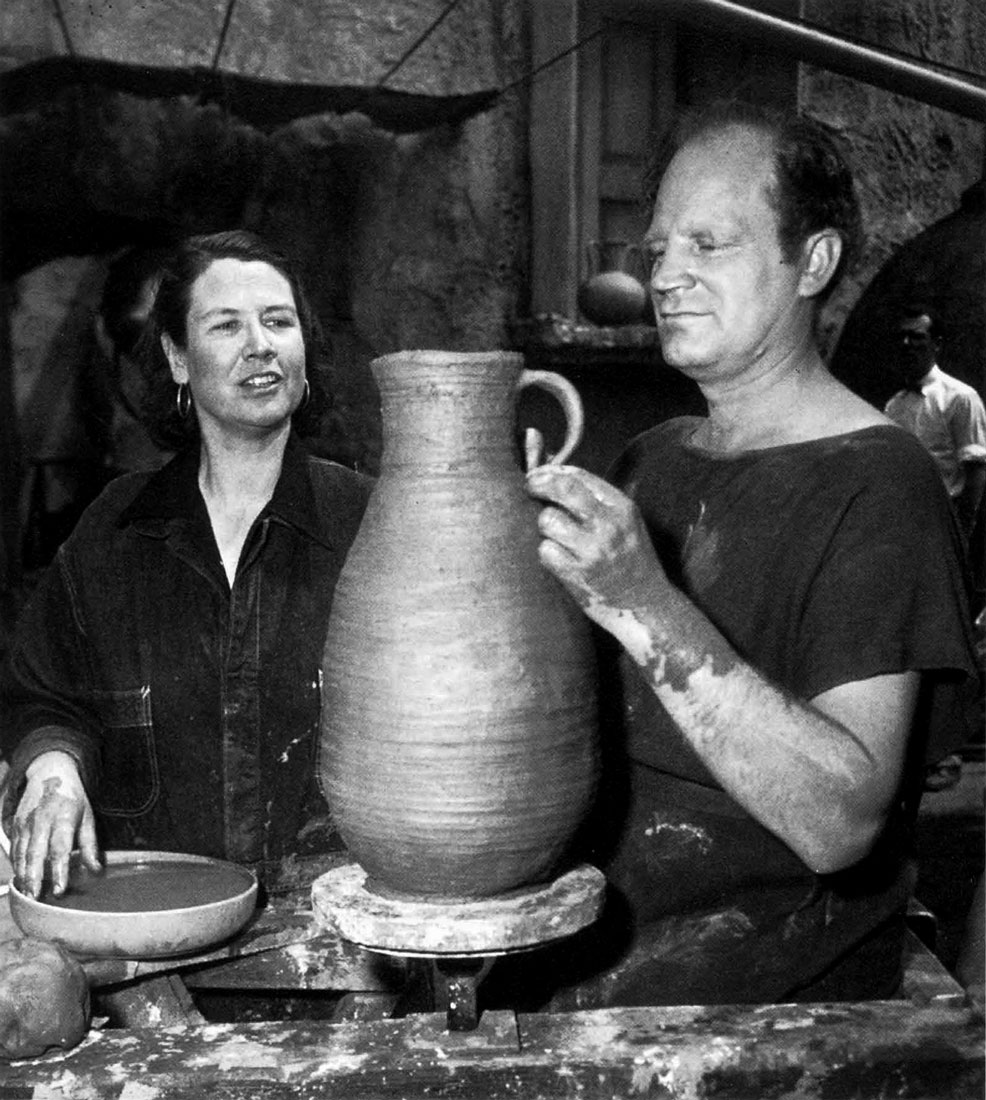
Otto: I had been in the Air Force and flew twenty-five missions over Europe. During my time off I went to visit Leach's pottery in England. I didn't know who Bernard Leach was, but I saw him throwing on the wheel. Before the war I had worked as a woodturning apprentice in Henniker [New Hampshire]. When I returned home after the war, I thought, "Well, clay is more of a challenge to work in than wood. You can just take a lump and make something of it." I guessed I'd take a look and see, and went to enroll in the League class where Vivika was teaching.
Vivika: In the beginning Otto coiled pots because I start everybody coiling. Then he began working on the wheel.
Otto: We mixed our own clay at the League. That old Kentucky flower pot clay was marvelous. Nowadays in schools they don't make clay; they buy it. But then we all knew what to do.
Vivika: Two years later we were married.
• • •
Dr. Lukens called from California to ask if we would come out to SC and take his place while he went to work in Haiti. I said to Otto, "Gael, if we go out and take the wheel, you could really learn to throw." We had only one wheel in New Hampshire, on which Otto would throw occasionally. His first pot was pretty good. I think we still have it-glazed with an 04 wood ash.
So we came out to California and were under contract at SC for a year. I was a visiting lecturer. They had wanted Dan [Rhodes] to come, but later the director, Donald Goodall, told me that the worst thing they ever did was not continue to hire me full time. I told Otto, "We're only here through the summer and you haven't really learned to throw." (Otto had taken a job with Douglas and worked on an experimental project.) I said, "Give up your job and work on the wheel all summer." The next morning they called and asked me to stay for two more years. So we did.
In May of the first year I received a call from the Fox Movie Studio asking if I could provide three students and come as advisor for the shooting of the film "Demetrius and the Gladiators." I arranged for three students to be at the Fox lot at 5 a.m. When we arrived, one student had a beard, one a crew cut and one did not come. Otto had to fill in. We quickly coiled large jugs for the wheel of the blind potter. The kilns were all wrong-the smoke came out the bottom-so they had to be rebuilt quickly. I had to check each set. Someone put white plaster molds in and they had to be moved.
The following December, the day before Christmas, they called again and asked me to come to the Fox lot offices. They were starting to film "The Egyptian." They wanted 57 large amphoras with necks, 57 beer amphoras, 57 small, fat amphoras, 48 drinking amphoras, lotus cups and drinking shells, and so forth. It took·16 tests to get the right turquoise for technicolor.
Two college students helped Otto coil, and we paid the living wage. One girl made only coils. I threw all the water pitchers 38" high, and all the amphoras and bowls. We completed all pieces between the semesters in four weeks. All amphoras had pointed bases. I made six large press molds and the bases were pressed and the rest coiled. We used two tons of clay, buff and red, and the scraps were reclaimed and used by students in their classes.
The final order was for three sizes of four canopic jars with covers of four heads: sphinx, Horus, jackal and ape. Then I also had to make covers that could be used on them for the kitchen scene. We made a total of 751 pieces. The set designer said I was $80 off on my bid. I did not ask him if it was over or under. The next day, classes were to start and everything was in order in the classroom. Mrs. Rifstaehl, of the Brooklyn Museum, was the advisor for the film. Her husband had gone into King Tut's tomb with Carter.
At the conclusion of our stay at SC, we decided to return to the East Coast. Susan [Peterson] came over one morning and asked if I would consider going to the Chouinard Art Institute because she had been asked to teach at SC. I suggested Carleton [Ball], but he couldn't come. This time I said to Otto, "You can learn high temperature and we can get back into it." So we said, "Sure."
At Chouinard I developed their degree program. However, Disney [Studios] bought the school. The new director came over and threw out the costume and ceramics departments. I didn't know what was going to happen in the resulting confusion, so we decided to go back East. But the next four years the department continued to graduate the majors.
In the meantime, the dean of the Rhode Island School of Design had came out and visited our department in Chouinard on a free day. The studio was crowded. He kept pursuing me to come East. Finally he called again to ask if I would come and teach. I replied, "How much do you pay?" He told me, "From 5 to 9 thousand." I said "I'll come for 9 thousand." He gulped and said, "All right".
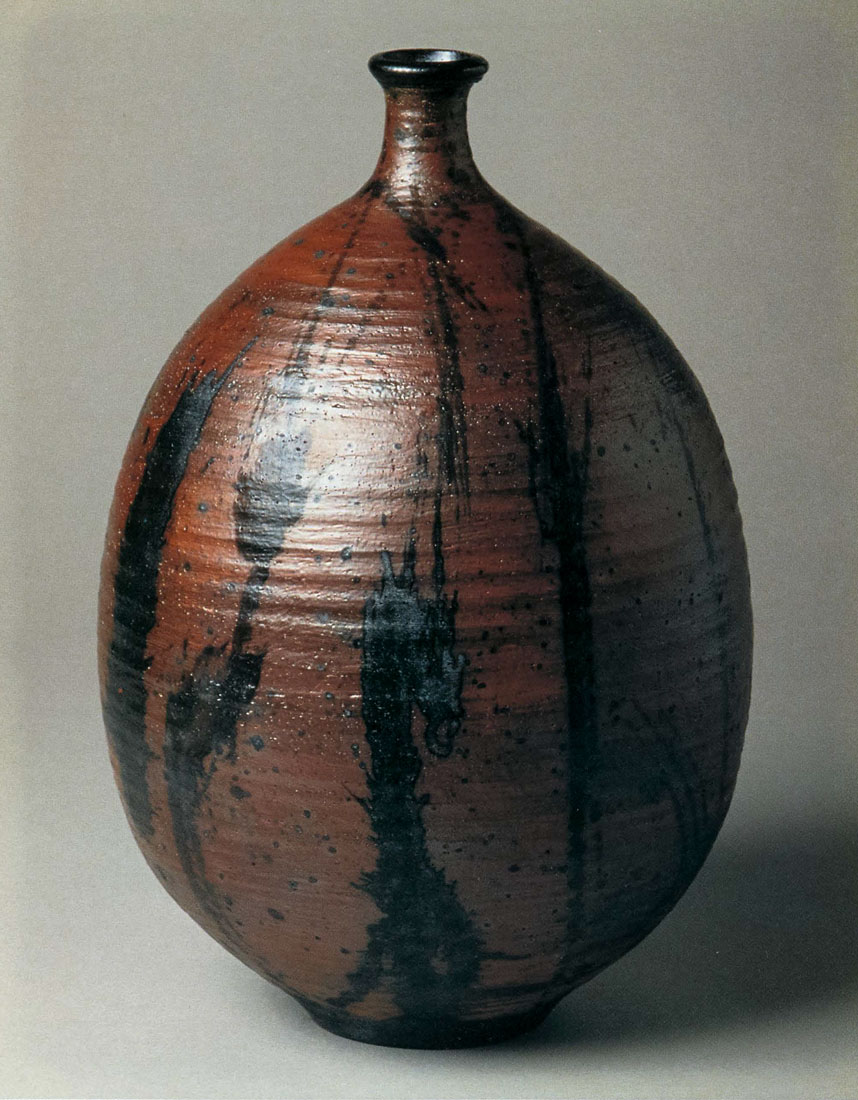
I took the job at RISO for two years. [The first morning] I arrived there at the appointed time of 8:30, and didn't find any students. Some came in at 8:45, some at 9 or 9:30. I told them, "I start at 8:30, and I lecture in the morning. I want you here. I'm not going to repeat myself." The next time there were a few students in at 8:30. They said, "Well, we don't have to go to other places on time." I told them, "You've got to here," and I locked the door.
[Dean]Franklin came down. He demanded, "What's the meaning of this?" I said, "I want my class here on time. I'm paid to teach at 8:30 for three hours in the morning." He said, "Well, they really don't have to." I didn't have much respect for them after that. At faculty meetings there was the feeling of why bother with the girls, they're only going to get married. Maybe things have changed now.
• • •
Back in New Hampshire, I began working again for the League of Arts and Crafts. In addition, Otto and I worked like mad making pots and had quite a number of shows in places such as Washington and Philadelphia.
The first winter we had very little snow; the second we had a little snow. The last year we were there we had lots of snow, and it was 30 below for two solid months. Everything had to be done inside, and our studio looked
like a Collier Brothers Maze- everything piled up.
That year, three days before Christmas, we received a letter from Beatrice [Wood] in California, saying that now that she was older it was more difficult to take care of her yard and make pottery. I said to Otto, "That's too bad because she has such a beautiful studio." I remembered that when we lived in California we often went to visit her, and sometimes to cook and help with her throwing. It was a wonderful, relaxing time for me.
Quick as a flash, Otto said, "Call her up and see if her house is for sale." I did. Beatrice told me that it had been on the market for four years. She was giving her land to the Happy Valley School, the foundation begun by Krishnamurti. They wanted her to live up there, so she had to sell her house. Otto then said, "Tell her not to sell it until you get out there tomorrow." Otto had made up his mind to leave New Hampshire. I thought I'd be there forever. Otto was tired of shoveling snow.
So I came to California and looked at the house in Ojai. I stayed a week checking everything out. Beatrice had put in a new water tank, and natural gas was available. Food in the stores was much cheaper than in New Hampshire. I calculated that if we came we could save about $7000 a year. The taxes were very little (this was before Proposition 13). Our taxes in New Hampshire that year were $2000.
So we bought it.
• • •
That year we moved to California, and, as a result, we lost our New Hampshire Christmas trade. To pay for the moving, we had a huge barn sale. Then we hired a tremendous van to transport our goods across the country and put everything into it- our kiln that had been in the League, all our wheels, all the kiln shelves, all the bats, ware boards and all our materials. We wanted to set up our pottery right away, you see. At our barn sale we sold $7000 worth of materials, enough to pay for the entire move to California.
Our move to California in 1972 was the best thing we did. Now, every day, Otto says, "This is paradise!" We like the weather, there is business year 'round, and we sell 95% of our work directly from the house. We're supposed to be closed Mondays, but it's usually our best day. People stay over at the Inn and come up. The first couple of years I kept track of our expenses and income, and it seemed to be favorable in comparison with past years because the living here was much cheaper.
Yes, we're products of our background. Otto and I divide our responsibilities according to our interests. Otto shops and takes care of the animals. I prepare the food and take care of the business. I do the income tax and quarterly sales tax, and pay all the bills.
Ojai is a community of eight or nine thousand people, with many more living in the valley. Ojai means "nest" in the Chumash Indian language. In the old days it was a sacred place for the Indians, and there still are a few Indians here. It's a beautiful valley, and we're surrounded by mountains on all sides.
A lot of artists live here, too. When we first came, there was only Beatrice [Wood]. Bill Winterburn started a group for potters now called the Ventura Potters' Guild. Seven potters have moved into Ojai to work. The community is full of actors and screen writers, as it is so close to the film studios of LA.
• • •
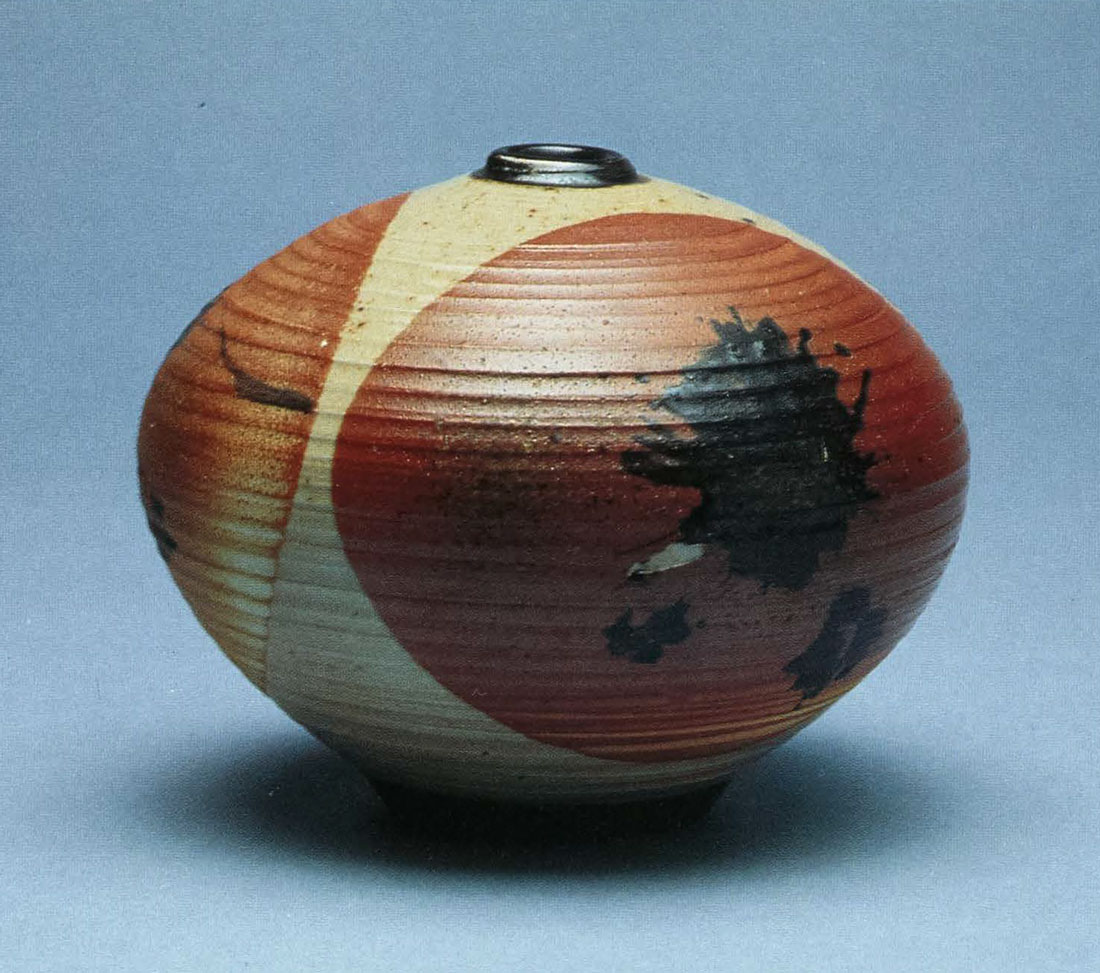
Finally we decided we'd better build a salt kiln. I was afraid that if we didn't build another one [like the one in New Hampshire] we'd never get one. The new salt kiln went up like a dream, in five hours. We bought new bricks (we thought we paid through the nose for them, but not compared to today's prices!). We put Missou hard brick- 40 percent clay and 60 per-cent alumina--on the bottom, around the fire ports. I cut out the arch form and got #1 and #2 straights to put right up. We've fired the kiln for eighteen years and it's held up beautifully. The only thing that we've done is to put strapping around it, because we're right on top of the San Andreas fault. We haven't had a serious earthquake yet- knock on wood! (It survived this last one, although we were badly shaken.)
At SC, I had taught a class for architects, so they would know how to order things and be aware of what they were getting. One of the students, a very successful architect who since has always come to our sales, called us one day and said he had acquired a building near the Santa Ana racetrack and turned it into rentals. "There's a kiln here," he said. "So come down and see if you can use it." It turned out to be a big, double-car Halverson kiln. I said to Otto, "It'll cost us $2000 to move." To the architect I said, "We just can't afford more than $1500, and we'll probably have to get a loan for that." He laughed. I think he was going to give it to us. "Now I can go to China," he said. So we got it.
We invited Mr. Halverson to come up and look at it, because the porcelain burners had been damaged in transit. "You know," he said, "this kiln is worth $6800 new." All we had to do was fix the burners. It only cost us $500 to repair them, and the moving bill was only $400. I gave one of the cars to a girl who wanted to build a kiln. We just use one car because we want it in the carport. Now all our kilns are outside. In New Hampshire, our kiln was inside the building, and the work room was always filled with carbon.
We had been here in Ojai about twenty years when Fred [Olsen] called one day and asked us to come down [to Mountain Center] to help fire his anagama woodburning kiln. We did and really enjoyed it. Now we've been there about ten times. Later, Dan [Rhodes] asked us to come up and help fire his kiln. So we began liking the effect of woodfiring on our pots and eventually built our own kiln. I would have preferred a two-chambered kiln, but didn't want to go up and down stone steps all the time to load everything. It's bad enough walking back and forth the eighty feet from our studio.
The ash effect is what we look for in woodfiring. We don't put any glaze on the pots-well, I've just glazed a few pieces, and that's sort of exciting. We really want the ash to burn into the clay. When Jun[Kaneko] was here, he was quite amazed at the results we were getting after only twelve hours of firing. I asked him why they fired so long in Japan and he told me they want to see the effect when the ash sinks into the surface of the clay.
We make our own clays in a dough machine, with five clays specifically for salt glazing. Recently we read in the paper where Jack Wolfe [in New York] still had Jordan clay, so we immediately ordered some. It cost us an arm and a leg to get it here, but it's just beautiful when fired in the wood kiln. We're getting glaze effects now we haven't gotten on anything else. When I was at Rhode Island you could still get Jordan.
We still use my old porcelain formula: 25, 25, 25, 25. If we do run out of porcelain, however, we get it from Laguna, which has now bought out Westwood. Our red clay is a formula that I used at Chouinard, except that you can't get Alberhill any more. But it doesn't take the ash very well. We can't use it in the salt kiln, either. So we take our porcelain scraps and put them through with one-half red clay. For salt, I usually make up a body using Missouri fire clay and XX Saggar. I made a whole series of plates that are toasty pink around the edges. I like a celadon glaze on it because it's not as muddy as you see on so many dark brown pots.
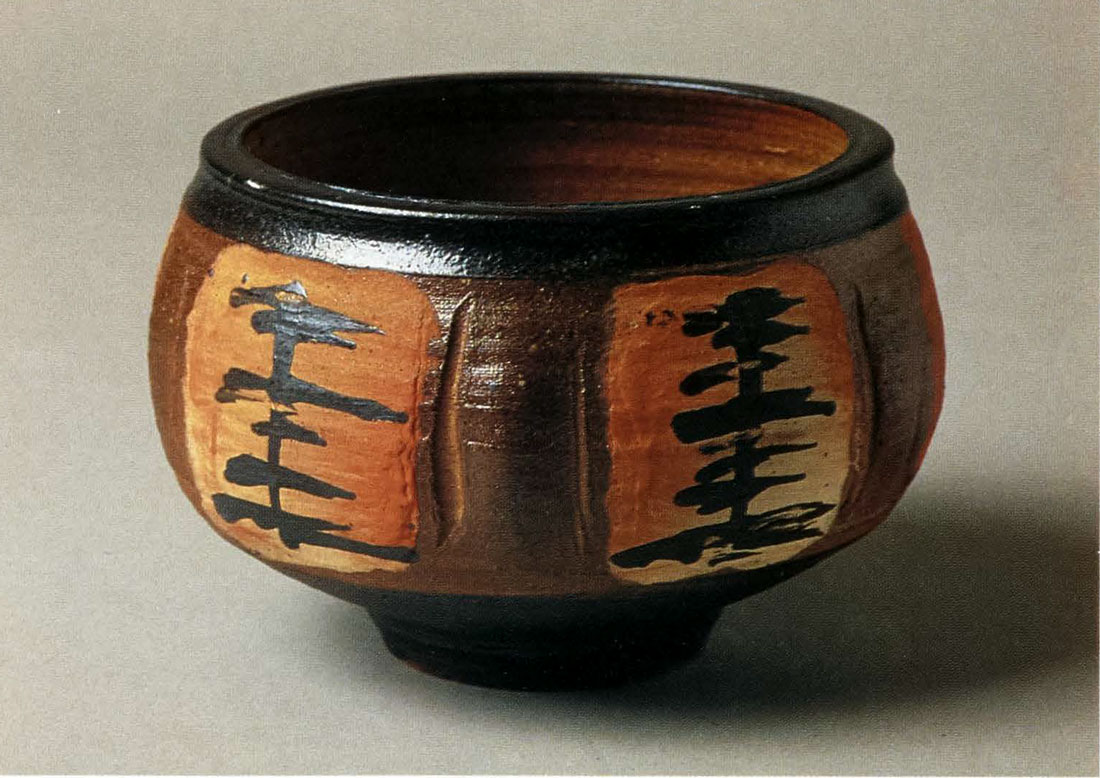
For years I've been very definite in my throwing, but lately I've been throwing tea bowls, trying to be loose,
throwing quickly in one pull, so you can feel the stroke.
We're both known for our bottles. I used to sell many little open bowls. Customers liked the delicate porcelain things. Otto likes to make a series of large bowls, and when they're all sold he makes some more.
We love color. I'm always trying new glazes. From the very beginning, if I had a new glaze, I would immediately put in test tiles with cobalt, copper, chrome, nickel, potassium, manganese, so in one fell swoop I would know what it gives me. Then it is mine.
We work on the pots together, and we both sign them. Otto prints and I write. Archaeologists are going to have an awful hard time, because sometimes Otto forgets to sign and sometimes I do, or we sign each other's. Sometimes they go unsigned.
I've looked at, read about, and always been interested in anything that was pottery. It may sound pretentious, but when I first started, I decided I was going to know everything I could about ceramics-the background, the technology, everything. There was a wonderful library in San Francisco called Mechanics Library where you could take out ten or twenty books. I took out books such as Heatherington, even though I didn't have a clue as to what he was talking about before I went to Alfred and found out.
I remember that one of the most important influences on me at the time was an exhibition set up by a man who had won a free trip to Japan at the World's Fair-he correctly guessed the number of pearls in a jar. When he returned he brought with him a collection of pots by Hamada, Kawai and several of the early Japanese potters. It was wonderful to see. Everybody in California then was biscuiting at cone 04 and glazing at 013. Things have certainly changed!
• • •
When I'm at NCECA, I'm so bored with all the talk of sculpture. Everyone thinks they have to make sculpture. If they say, "Who wants to listen to talk of copper reds?" I say, "There are only two thousand potters who might like to hear it." That's why I suggested the Glaze Doctor sessions when I was on the NCECA board. Think how that panel has grown in attendance!
I also get annoyed when they say, "Oh, she's Alfred," referring to the aesthetic as a stereotyped approach to clay. When I was there everyone did their own thing. There wasn't any one special glaze. Mr. Harder gave me one glaze, the Alfred Celadon. Now everyone uses it at glaze classes; it went everywhere.
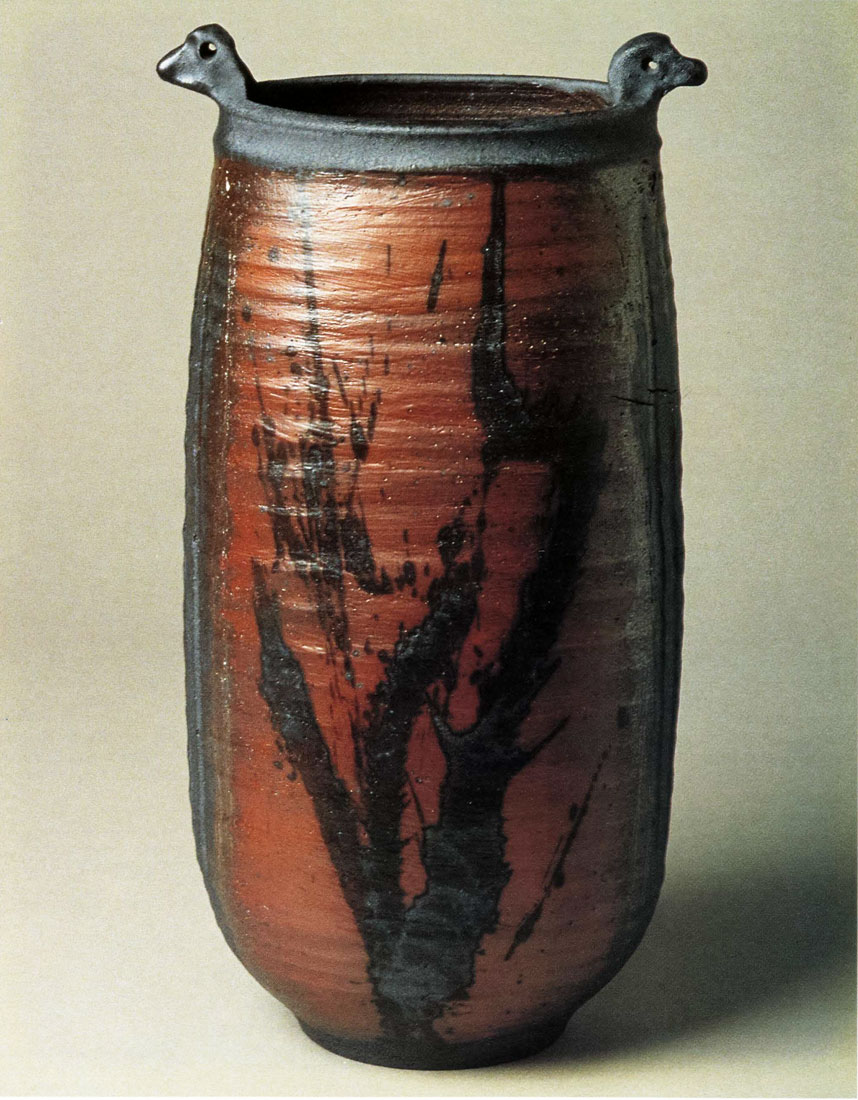
Furthermore, I don't know how Otto and I came to be associated with what some call "the brown pot aesthetic," whatever that is. When stoneware started, most people worked in dark color, and reduction turned everything sort of brown. Peter [Voulkos] was doing all those dark stoneware things. But I always talked color. Ken Price was a student of mine at SC and made stoneware and later big sculpture. But I said, "You wait, Ken's going to go to color." And in the next show there were big areas of color in his work, because he had moved on.
Look. Shaner or Ferguson or someone else made that glaze at Alfred. That's color. Otto and I have an orange glaze that we call "one hundred". We've always gotten tones of yellow and orange. In fact, Laura [Andreson] wrote a long time ago that I consistently tried to get color in my pots. You need color.
Well, the bottom line is that we really just like to make pots. Whatever else, we believe in the purity of form.

